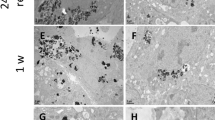Abstract
Fullerenes C60 are used in various fields of industry; therefore, issues of studying their biosafety for living organisms, their biodistribution in organs and tissues organs and tissues of laboratory animals, and their induction of cellular pathologies are very important. In recent years, analytical and transmission electron microscopy (TEM) have proven their efficiency in detecting carbon nanoparticles in biological samples. Combining these methods can reveal pathological changes in cells induced by nanoparticles and detect accumulations of nanoparticles in them. The aim of the study was to reveal cellular pathologies upon direct short-term administration of fullerene C60 nanoparticles into the gastrointestinal tract (GIT) of rats and to detect nanoparticles in samples of the small intestine and liver. The histological and ultrastructural analysis did not reveal pathological changes in the small intestine, but degenerative changes in hepatocytes were indicated in the form of accumulation of lipid inclusions. High-performance liquid chromatography and analytical TEM revealed no accumulations of fullerene C60 nanoparticles in the studied samples. Probably, hepatosteatosis may be a consequence of the indirect influence of C60 nanoparticles on liver cells. Apparently, the surface of fullerene C60 undergoes modifications in the GIT, and its contact with the cells of the small intestine induces the synthesis of proinflammatory cytokines, with their subsequent entry into the liver, leading to the rapid development of fatty degeneration. Revealing and identifying modified C60 nanoparticles and their metabolites, in turn, is a complex problem, which in the future can be solved using radiotracers, mass spectrometry, and modern metabolomic technologies.







Similar content being viewed by others
REFERENCES
R. Bakry, M. Najam-ul-haq, and C. W. Huck, Int. J. Nanomed. 2 (4), 639 (2007).
A. Husen and K. S. Siddiqi, J. Nanobiotechnol. 12, 16 (2014). doi
O. Zaytseva and G. Neumann, Chem. Biol. Technol. Agric. 3, 1 (2016). https://doi.org/10.1186/s40538-016-0070-8
I. Steffensen, J. Alexer, M. Binderup, et al., (Norwegian Scientific Committee for Food Safety, 2010), p. 7.
V. A. Shipelin, I. V. Gmoshinski, V. A. Tutel’yan, et al., Nanotechnol. Russ. 8, 810 (2013). https://doi.org/10.1134/S1995078013060141
F. Moussa, F. Trivin, R. Céolin, et al., Fullerene Sci. Technol. 4, 21 (1996). https://doi.org/10.1080/10641229608001534
P. Rajagopalan, F. Wudl, R. F. Schinazi, and F. D. Boudinot, Antimicrob. Agents Chemother. 40, 2262 (1996).
A. S. Shebanova, A. G. Bogdanov, T. T. Ismagulova, A. V. Feofanov, P. I. Semenyuk, V. I. Muronets, M. V. Erokhina, G. E. Onishchenko, M. P. Kirpichnikov, and K. V. Shaitan, Biophysics 59, 284 (2014).
G. Griffiths, Encyclopedia of Molecular Cell Biology and Molecular Medicine, 2nd ed. (Wiley-VCH, Weinheim, 2006), p. 21.
G. Botton and S. Prabhudev, in Springer Handbook of Microscopy (Springer, New York, 2019), p. 345.
R. M. Glaeser and G. Thomas, Biophys. J. 9, 1073 (1969).
G. E. Onishchenko, M. V. Erokhina, S. S. Abramchuk, et al., Bull. Exp. Biol. Med. 154, 265 (2012).
G. Plascencia-Villa, C. R. Starr, L. S. Armstrong, et al., Integr. Biol. 4, 1358 (2012). https://doi.org/10.1039/c2ib20172k
R. S. Rhodes and M. J. Karnovsky, Lab. Invest. U. S. 25, 220 (1971).
S. Yamago, H. Tokuyama, E. Nakamura, et al., Chem. Biol. 2, 385 (1995). https://doi.org/10.1016/1074-5521(95)90219-8
T. Baati, F. Bourasset, N. Gharbi, et al., Biomaterials 33, 4936 (2012). https://doi.org/10.1016/j.biomaterials.2012.03.036
V. A. Shipelin, E. A. Arianova, E. N. Trushina, et al., Gigiena Sanit. 2, 90 (2012).
G. Volkheimer, Adv. Pharmacol. Chemother. 14, 163 (1977). https://doi.org/10.1016/s1054-3589(08)60188-x
V. A. Shipelin, L. I. Avren’eva, G. V. Guseva, et al., Vopr. Pitan. 81 (5), 20 (2012).
E. V. Litasova, V. V. Iljin, A. V. Sokolov, et al., Dokl. Biochem. Biophys. 471, 417 (2016). https://doi.org/10.1134/S1607672916060119
B. F. Pycke, T. C. Chao, P. Herckes, et al., Anal. Bioanal. Chem. 404, 2583 (2012). https://doi.org/10.1007/s00216-012-6090-8
T. Halenova, N. Raksha, T. Vovk, et al., Int. J. Obes. 42, 1987 (2018). https://doi.org/10.1038/s41366-018-0016-2
T. I. Halenova, I. M. Vareniuk, N. M. Roslova, et al., RSC Adv. 6, 100046 (2016). https://doi.org/10.1039/C6RA20291H
R. Yachi, C. Muto, N. Ohtaka, et al., J. Clin. Biochem. Nutr. 52, 146 (2013). https://doi.org/10.3164/jcbn.12-101
F. Wrer, S. Liebig, and S. Marhenke, et al., Cell. Death. Dis. 11, 212 (2020). https://doi.org/10.1038/s41419-020-2411-6
N. Mariappan, C. M. Elks, B. Fink, and J. Francis, Free Radic. Biol. Med. 46, 462 (2009). https://doi.org/10.1016/j.freeradbiomed.2008.10.049
C. P. Day and O. F. James, Gastroenterology. 114, 842 (1998).
I. Gitsov, A. Simonyan, L. Wang, et al., J. Polymer Sci., A 50, 119 (2012). https://doi.org/10.1002/pola.24995
Y. Liu, F. Jiao, Y. Qiu, et al., Nanotechnology 20, 415102 (2009). https://doi.org/10.1088/0957-4484/20/41/415102
K. Xiang, Z. Dou, Y. Li, et al., Nanosci. Nanotechnol. 12, 2169 (2012). https://doi.org/10.1166/jnn.2012.5681
ACKNOWLEDGMENTS
The authors are grateful to L.S. Vasilevskaya for her help in conducting the experiment on an isolated loop of rat intestine.
Funding
The study was supported by subsidies for implementation of a state task within the Program of Fundamental Scientific Research of the Russian Federation Ministry of Education and Science (topic no. 0529-2019-0057).
Author information
Authors and Affiliations
Corresponding author
Rights and permissions
About this article
Cite this article
Masyutin, A.G., Erokhina, M.V., Shipelin, V.A. et al. Short-Term Introduction of Fullerene C60 Nanoparticles in Rat Small Intestine Induces the Rapid Development of Hepatocyte Pathology. Nanotechnol Russia 15, 483–491 (2020). https://doi.org/10.1134/S1995078020040102
Received:
Revised:
Accepted:
Published:
Issue Date:
DOI: https://doi.org/10.1134/S1995078020040102




